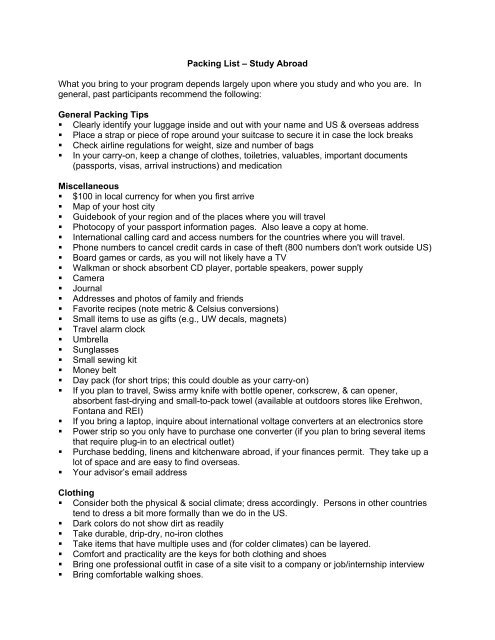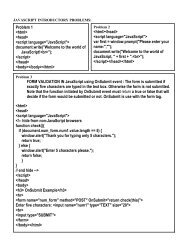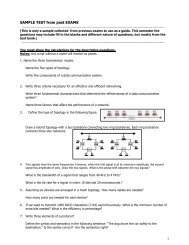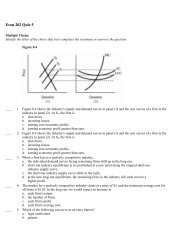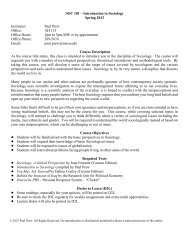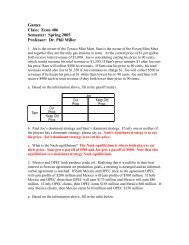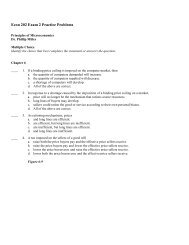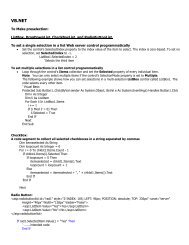Packing List â Study Abroad What you bring to your ... - Krypton
Packing List â Study Abroad What you bring to your ... - Krypton
Packing List â Study Abroad What you bring to your ... - Krypton
You also want an ePaper? Increase the reach of your titles
YUMPU automatically turns print PDFs into web optimized ePapers that Google loves.
<strong>Packing</strong> <strong>List</strong> – <strong>Study</strong> <strong>Abroad</strong><br />
<strong>What</strong> <strong>you</strong> <strong>bring</strong> <strong>to</strong> <strong>you</strong>r program depends largely upon where <strong>you</strong> study and who <strong>you</strong> are. In<br />
general, past participants recommend the following:<br />
General <strong>Packing</strong> Tips<br />
• Clearly identify <strong>you</strong>r luggage inside and out with <strong>you</strong>r name and US & overseas address<br />
• Place a strap or piece of rope around <strong>you</strong>r suitcase <strong>to</strong> secure it in case the lock breaks<br />
• Check airline regulations for weight, size and number of bags<br />
• In <strong>you</strong>r carry-on, keep a change of clothes, <strong>to</strong>iletries, valuables, important documents<br />
(passports, visas, arrival instructions) and medication<br />
Miscellaneous<br />
• $100 in local currency for when <strong>you</strong> first arrive<br />
• Map of <strong>you</strong>r host city<br />
• Guidebook of <strong>you</strong>r region and of the places where <strong>you</strong> will travel<br />
• Pho<strong>to</strong>copy of <strong>you</strong>r passport information pages. Also leave a copy at home.<br />
• International calling card and access numbers for the countries where <strong>you</strong> will travel.<br />
• Phone numbers <strong>to</strong> cancel credit cards in case of theft (800 numbers don't work outside US)<br />
• Board games or cards, as <strong>you</strong> will not likely have a TV<br />
• Walkman or shock absorbent CD player, portable speakers, power supply<br />
• Camera<br />
• Journal<br />
• Addresses and pho<strong>to</strong>s of family and friends<br />
• Favorite recipes (note metric & Celsius conversions)<br />
• Small items <strong>to</strong> use as gifts (e.g., UW decals, magnets)<br />
• Travel alarm clock<br />
• Umbrella<br />
• Sunglasses<br />
• Small sewing kit<br />
• Money belt<br />
• Day pack (for short trips; this could double as <strong>you</strong>r carry-on)<br />
• If <strong>you</strong> plan <strong>to</strong> travel, Swiss army knife with bottle opener, corkscrew, & can opener,<br />
absorbent fast-drying and small-<strong>to</strong>-pack <strong>to</strong>wel (available at outdoors s<strong>to</strong>res like Erehwon,<br />
Fontana and REI)<br />
• If <strong>you</strong> <strong>bring</strong> a lap<strong>to</strong>p, inquire about international voltage converters at an electronics s<strong>to</strong>re<br />
• Power strip so <strong>you</strong> only have <strong>to</strong> purchase one converter (if <strong>you</strong> plan <strong>to</strong> <strong>bring</strong> several items<br />
that require plug-in <strong>to</strong> an electrical outlet)<br />
• Purchase bedding, linens and kitchenware abroad, if <strong>you</strong>r finances permit. They take up a<br />
lot of space and are easy <strong>to</strong> find overseas.<br />
• Your advisor’s email address<br />
Clothing<br />
• Consider both the physical & social climate; dress accordingly. Persons in other countries<br />
tend <strong>to</strong> dress a bit more formally than we do in the US.<br />
• Dark colors do not show dirt as readily<br />
• Take durable, drip-dry, no-iron clothes<br />
• Take items that have multiple uses and (for colder climates) can be layered.<br />
• Comfort and practicality are the keys for both clothing and shoes<br />
• Bring one professional outfit in case of a site visit <strong>to</strong> a company or job/internship interview<br />
• Bring comfortable walking shoes.
Toiletries<br />
• Don't overs<strong>to</strong>ck on <strong>to</strong>iletries; most things are available in major cities abroad. Women may<br />
want <strong>to</strong> <strong>bring</strong> a preferred brand of tampons or pads, as they may not be as readily available<br />
abroad.<br />
• Transfer liquids from breakable containers in<strong>to</strong> plastic containers; use tape <strong>to</strong> seal the lids<br />
when traveling or pack them in ziplock bags <strong>to</strong> separate them from clothing<br />
• Prescription drugs for the duration of <strong>you</strong>r time abroad<br />
• Extra eyeglasses<br />
• Pocket pack of Kleenex<br />
Voltage<br />
Most appliances <strong>you</strong> have purchased in the U.S. are designed <strong>to</strong> work on 110 voltage, while<br />
most of the world outside the U.S. and Canada operates on 220 voltage. To convert the 220<br />
voltage energy <strong>to</strong> 110 voltage (for <strong>you</strong>r appliance <strong>to</strong> function), <strong>you</strong> will need <strong>to</strong> purchase a travel<br />
voltage converter (or, if the appliance is relatively inexpensive, purchase a new one in the host<br />
country). Countries that operate on 220 voltage include Austria, Chile, China, Denmark, Hong<br />
Kong, Norway and the United Kingdom. Countries that use both 110 and 220 voltage within<br />
their borders include France, Germany, Italy, Mexico, Singapore, Spain and Sweden.<br />
Voltage isn’t the only thing that varies from country <strong>to</strong> country. Electrical wall outlets also differ<br />
in shape, assortment and arrangement of holes. To be prepared, make sure <strong>you</strong> get an adapter<br />
set <strong>to</strong> go with the converter.


